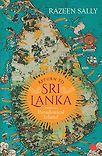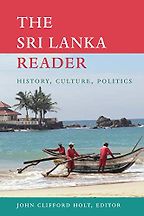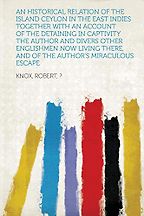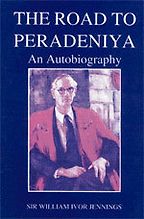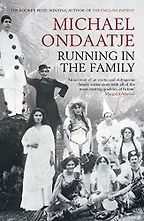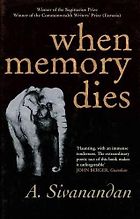You were born in Sri Lanka and lived there until you were 12. You then rediscovered it as an adult so, in a way, you’ve experienced it as an outsider as well. Before we get to the books, I wondered whether, as an introduction, you could tell me why Sri Lanka is such a fascinating place to discover?
There’s the immediate charm of the place. Most of it is very green and lush—that’s the wet zone of the country, which covers over half of the landmass. I like to think of the Sri Lankans as the Irish of Asia or the Irish as the Sri Lankans of Europe, because they’re very friendly, open, warm and welcoming. It’s an incredibly diverse country, culturally, ethnically and religiously. You see that expressed in the way people dress and what they eat, where they go to worship, and the languages: Sinhala and Tamil as well as English. That’s all on the surface.
The attraction of Sri Lanka beyond that, for me, is all wound up with being half Sri Lankan and having been born and spent my childhood there, and then coming back to write a travel memoir about the country. My main fresh discovery, traveling around the island properly, was the back-of-beyond places that I didn’t really get to see as a child. Getting under the skin of people in these places, walking all over the landscapes, was just wondrous. I can’t think of anywhere else—at least that I’ve been to—where in a comparable space you have as much variety of people, cultures, flora, fauna, and landscapes. You don’t have to travel long distances in Sri Lanka to come across something quite different. In a mid-sized island roughly the size of Ireland, you have an incredible variety.
The other thing I would point to about Sri Lanka is its baffling complexity. I call it ‘paradoxical’ in the subtitle of my book, and for a small country with a population of around 20 million, there are just so many contradictions. In the book, I say it’s a heaven-and-hell country, engulfed and consumed by its own extremes. The obvious paradox is this beguiling charm I mentioned, especially of Sinhala-Buddhist culture in the lush, green wet zone, alongside an astonishing record of violence that leaves admiring foreigners completely puzzled and in a state of consternation. They just can’t explain it. That, among other contradictions, always puzzled me as a child, and they lingered with me during my three decades or so of absence. I suppose that central paradox of beguiling charm and violent eruptions was the really hard puzzle that I set off on my travels with, when I came back to rediscover Sri Lanka in my mid-40s.
So, that’s the attraction of Sri Lanka for me, in a nutshell.
I suppose to get a grip on these contradictions you need to have an understanding of the history?
Yes, which I knew little about until my mid-40s. I didn’t really get a sense of Sri Lanka’s many-layered history as a child. My school career was highly fragmented, back and forth between Britain and Sri Lanka: I think I changed schools 10 times before I turned 16.
These travels and my book project have been a good excuse for me to dive into Sri Lanka’s history, cultures and religions. It’s incredibly complicated which makes it interesting: there are puzzles to unravel.
On that note, let’s turn to the books and in particular The Sri Lanka Reader which you mentioned as the best place to start.
Of all the books I’ve read on Sri Lankan history, this is the one that I found best in terms of a sweeping overview of a blend of history, politics and culture, from many different angles and authors—as opposed to having, say, a textbook by one author. There is a rather good textbook on the history of Sri Lanka by Professor K.M. de Silva. That’s the one most people go to, especially if they’re not specialist historians.
But for an introduction that’s erudite and not superficial, The Sri Lanka Reader is the one I would go to. It came out about 10 years ago. It’s edited by John Holt, who is now emeritus professor at Bowdoin College in Maine. He’s a specialist on Buddhism and its relationship to Sinhala culture and has a long association with Sri Lanka. What he’s put together in this book are these very accessible short excerpts that cover the whole range of history—about 2,500 years of it—taking us all the way to the end of the Civil War in 2009. Some of the authors are long dead, some still living.
Can you give me a sense of the kind of excerpts that he includes?
The very first entry, in the section on ancient and medieval history, is from the Mahavamsa, the national epic. It translates from the Sinhala as ‘Great Chronicle.’ There are many chronicles, but this is the one that’s really elevated to Olympian status. It was written by a leading monk, Mahanama Thera, in the fifth century CE, most probably. He was the abbot of one of the three main monasteries in the capital city of Anuradhapura and an uncle of a king. The Mahavamsa is very tendentious. It presents about 1,000 years of history, up until the fifth century CE, with Theravada Buddhism and Sinhala kingship and the alliance between the two in the foreground. Its style is what we would today probably call ‘magical realism’. The Buddha flew three times—before the age of flying machines—from North India to Sri Lanka. He said on his deathbed that Sri Lanka would be the cradle of his religion after his death. The founder of the Sinhala race, Vijaya, was the issue of the union between a lion and an Indian princess, and so on.
There is also a short account from Ibn Battuta’s travels on his stay in the 14th century, and a fifth-century account from a Chinese pilgrim monk, Faxian, about his visit to the Anuradhapura kingdom.
“I can’t think of anywhere else…where you have as much variety of people, cultures, flora, fauna, and landscapes”
Then there is a long middle section on the colonial encounter, which was roughly 150 years of Portugal, 150 years of the Netherlands, and 150 years of the British before independence in 1948. It’s probably the longest colonial encounter of any country in Asia.
I suppose my favourite entry in the book is from Leonard Woolf’s memoirs. He was in the Ceylon civil service for seven years in the early 1900s, and married the more famous Virginia when he returned to London. He was much more interested in the locals than he was in what he considered to be rather boring and pompous fellow colonial officials and their families. He wrote a marvelous novel, The Village in the Jungle, which is still famous in Sri Lanka. His second volume of memoirs, Growing, is set in the Ceylon of the period just over a century ago.
The Sri Lanka Reader ends with a short “Political Epilogue,” taking account of the end of the Civil War. The leading entry is by an eminent Sri Lankan journalist, Lasantha Wickrematunge, who wrote an editorial in his paper, the Sunday Leader, predicting his murder at the hands of the government. He criticized the government mercilessly, because of human rights violations and corruption, with the instruction that the article was to be published in the event of his murder. It was published on January 11th, 2009.
So the book covers a very, very broad spectrum and is highly readable.
You mentioned that the editor of this book, John Clifford Holt, is an expert on Buddhism. That’s a very important part of the story of the Civil War, isn’t it, the connection between politics and religion? Could you say a bit about that for people who don’t follow Sri Lanka closely?
Buddhism in Sri Lanka, whether you’re writing a travel memoir, as I did, or a history or current affairs book, is the proverbial elephant in the room. You can’t avoid it. Ethnic Sinhalese are roughly three-quarters of the population, and about two-thirds of the population are Sinhala Buddhists (other Sinhalese being mainly Christian). The long laborious process of writing a book got me much deeper into Buddhism in Sri Lanka than I ever did as a child and got me to go into the history of it.
What you see today is a ritualistic, almost pagan worship because Sinhala Buddhists tend to worship a whole range of gods and spirits with the Buddha as the central character in the pantheon. This has little to do with original Buddhism. That’s combined with a Buddhism that, particularly since independence, has become highly politicized and involved with money and business, including lots of shady characters. It drives a chauvinist, supremacist, even racist political agenda. So that’s the Buddhism that the observer sees on the surface.
The origins of this go back to the founding of Buddhism in Sri Lanka, because when Buddhism came, sometime in the third century BCE, it was linked to Sinhala kings in the Anuradhapura kingdom from the outset. That political connection has always been there and was only interrupted during the colonial encounters with the Portuguese, Dutch and British. It was then restored with independence. It was Theravada Buddhism which really got anchored in Sri Lanka and came to monopolize Sinhala Buddhism. It tends to be doctrinally very conservative, without much evolution over 2000 years or more.
Get the weekly Five Books newsletter
The paradox is that for most of this time, Buddhism in Sri Lanka tolerated other religions, and there was a lot of syncretism. If you go to a Buddhist temple in Sri Lanka today, you will see Buddha statues worshipped alongside Hindu gods without worshipers thinking anything of it. You will see a lot of Hindu influence, particularly from Shaivite Hinduism in South India, which most Tamils in Sri Lanka practise. There are also Mahayana influences—because Mahayana coexisted with Theravada probably for the best part of 1,000 years before Theravada erased formal Mahayana religious orders and worship.
But the kind of political Buddhism we have in Sri Lanka today is much more exclusive, supremacist and discriminatory against other religions and their communities. While it has some historical precedents, this is more of a modern phenomenon. It’s mainly a feature of how a Buddhist revival that took place as a backlash against British rule in the late 19th century, went from being culturally expressive to politically expressive. As it acquired more of a political patina, especially with independence, it became wound up with a Sinhala Buddhist political agenda, largely directed against ‘others’. The others started off being elite Christians, and then became Tamils and now, more recently, especially with the Easter Sunday bombings in 2019, it’s Muslims. It’s all incredibly complicated but it’s not something that started the day before yesterday.
Let’s go back in time, then, to the 17th century and a book by Robert Knox, who was a prisoner in Sri Lanka. It’s called An Historical Relation of the Island Ceylon and it was published in 1681, when it caused quite a sensation. Tell me about that book, and why you’ve chosen it as a good one to read on Sri Lanka.
I think Robert Knox has a good claim to be the most important foreigner who lived in Sri Lanka in its recorded history because of this book. It’s still very readable and captures very vividly the politics, culture, and landscapes of the Kandyan kingdom in the central highlands of Sri Lanka in the middle of the 17th century. Knox was in captivity there for 19 years and the book is all the more remarkable because he wrote the first version in one go on the ship back from Batavia (what is now Jakarta) to London, completely from memory, because in captivity he never had access to pen and paper. A lot of accounts of that period, and in the centuries afterwards, were either made up or plagiarized or both. In his case, most of it has been corroborated by historical research. It’s fairly accurate, and indeed was used as a key reference by colonialists who had their eye on Ceylon in the 18th century, especially the British.
The author himself is absolutely fascinating. He led as varied a life as one could imagine. He took to sea early. He was on his father’s trading ship, the Anne, on its way to Fort St. George in Madras (occupied by the British at the time) when it lost its mast somewhere off the east coast of Ceylon and ran aground. He and his shipmates were captured by soldiers of the Kingdom of Kandy and taken inland to the hill capital and held captive there. His father died after the first year, and many of his other shipmates succumbed to drink and malaria. A few of them made it back to the mother country eventually.
For Knox, acquiring a copy of a King James Bible was top of the agenda. That was the only book he had: he read it and quotes from it assiduously. He says he took an oath of celibacy. He was relentlessly resourceful. He built his own houses, did market gardening and animal husbandry, knitted cloth caps, and walked around the kingdom as a pedlar. The reason he couldn’t escape is because the Central Highlands have a ring of mountains around them, a natural frontier. In those days it was covered by jungle and wild animals and was without roads. All the while Knox was observing very keenly and plotting his escape, which he eventually managed in 1680, through the animal-infested jungle to Dutch controlled territory, and eventually he made his way back to London.
The book became an instant bestseller. I think its wider legacy—going beyond what it has to say about the Sri Lanka and the Kandyan kingdom of the time—is that in all probability, Knox was the model for Daniel Defoe‘s Robinson Crusoe. The setting was somewhere else and the man who was stranded on a desert island was Alexander Selkirk. But we know that Defoe read that first edition of Knox’s book and was highly taken by it. When it comes to the descriptions of the resourcefulness of Robinson Crusoe, that’s Knox, not Alexander Selkirk.
For me, of central interest is what Knox has to say about the Kandyan kingdom of the time—and it’s not just of historical interest. It resonates with what goes on in politics and culture in Sri Lanka today.
In what way?
I quote some of the relevant passages in my book. Knox refers to the king of the time, Rajasinghe II, as an absolute tyrant. He indulged in wanton cruelty, invented methods of torture and had absolutely no regard for people’s human rights as we would nowadays call them. He threw people in jail at the drop of a hat, there was no real rule of law, and the justice administered by the nobility was for sale. Much of that rings true in Sri Lankan politics today.
Kandyan society was highly caste-riven at the time. The king was the only person allowed to sit on a stool with a high back and only the nobility could sit on stools. Everybody else had to sit on the floor. Now, that’s not how quite how things work in the Central Province of Sri Lanka today, where the hill capital of Kandy is located, but it’s still probably the most conservative part of Sinhala Sri Lanka.
Knox refers to the people worshipping a whole range of gods. They’re idolaters and pagans, he says, and the Buddha but one great god in the pantheon. That hasn’t changed very much. One thing that has changed is that Knox, with that observant eye of his, notices how the Kandyan king and the nobility and indeed ordinary people, are very tolerant of people of other religions. The king gave refuge to Muslims and Christians who fled persecution, first by the Portuguese, then by the Dutch. The last three kings of Kandy—before the British conquered the place—were actually Tamil Hindus from the south of India. They became ardent defenders of Sinhala Buddhism as that was their source of legitimacy, but they continued to import Hindu brides from South India who kept their religion. There were also Tamil merchants in the ancient pre-Kandyan kingdoms of Anuradhapura and Polonnaruwa, there Tamil was a court language because it was a trade language, and Brahmins officiated at court. During the Kandyan kingdom, there were waves of migration of artisans from what is now Kerala and Tamil Nadu who were Tamils and Hindus. So there was an incredible amount of religious tolerance and syncretism that took place along with everything else. That’s a legacy of Sinhala Buddhism that’s been erased from current thinking and indeed current historical memory.
You mentioned the British. Let’s go on to Sir Ivor Jennings’s autobiography. He was sent by the British Empire to set up a university in Colombo and advised on the country’s post-independence constitution. Fill me in on who he was and why we should read his autobiography.
Not many people living today have heard of Ivor Jennings, either in Britain or in Sri Lanka, but I think he was probably the most important foreigner to have an influence on Sri Lanka in the 20th century, and his story is largely unsung. He came in 1941.
Again, his is an interesting biography. He grew up fairly poor in a non-conformist family in Bristol. He was raised with those non-conformist virtues of hard work, thrift and self-improvement through education. He was a scholarship boy and ended up where I taught much later: he was a professor of constitutional law at a very young age at the LSE in the 1930s. Then he came to Ceylon, which was the making of him. Over the course of almost 15 years, not only did he turn the University College of Ceylon—what he called a “Government cram-shop”—into one of the finest universities in Asia, but he also published prolifically on the law, politics and the economy of Ceylon. He was a leading player politically in the runup to independence because he effectively wrote Ceylon’s first constitution, which is known as the Soulbury Constitution. It’s named after the commission that was set up to turn Ceylon from a colony into a dominion, but it should be called the Jennings Constitution because it’s his draft with minor amendments that became the constitution of Ceylon for the first 24 years after independence. So, Jennings is important for all those reasons.
The book is called The Road to Peradeniya. Now, for tourists who have been to Sri Lanka, Peradeniya will ring a bell because it’s on the tourist trail. The Royal Botanical Gardens are sited at Peradeniya, which is about 10 miles from the hill capital of Kandy. Lord Mountbatten had his headquarters for South East Asia Command there during the Second World War. But, for me, Peradeniya is its university campus, which has a wonderful setting. I’ve seen many university campuses and I can hardly think of one to rival Peradeniya for its sheer loveliness. Ivor Jennings laid the groundwork for it in the early 1940s, in wartime, in the Meda Oya valley with the Hantane ridge of hills in the distance. He wrote 200 pages of delegated legislation to make sure it came to life after the war and he was its first vice-chancellor.
“It’s a heaven-and-hell country, engulfed and consumed by its own extremes”
The Road to Peradeniya is his memoir of his upbringing and career before he came to Ceylon, and then of his time in Ceylon until the early 1950s. He wrote it intending to raise funds for a new art gallery for the university, but it languished in his archive. His last official position was as vice-chancellor of the University of Cambridge, and he died in 1965. This memoir was discovered gathering dust in his archive and published in the mid-1990s, by a former librarian of Peradeniya University, the university Ivor Jennings founded.
The book is of interest, for me, for several reasons. It gives us a sense of where Ivor Jennings came from and what made him tick. Now he was clearly a rather dour workaholic. He had many Knox-like characteristics. He believed in the virtue of hard work, of resourcefulness. Most Ceylonese exasperated him because they were too laid back. He was self-made, while the elite he interacted with came from gilded families: they didn’t need to work for a living. When they retired for their gins and tonics come five or six o’clock in the evening, he would repair to his study to do his writing.
The book’s tone is razor-sharp, the sentences are short and simple. It’s quite unlike most South Asian writing, especially literary writing, which is luxuriant, with these very long meandering sentences full of big words. His style is quite the opposite. It’s plain, and often dripping with condescension and sometimes rather cruel mockery of the people he has to deal with.
He’s especially scathing of the political class, though he makes two exceptions: for Oliver Goonetilleke who became the Governor-General of Ceylon, and for Ceylon’s founding father D. S. Senanayake, the country’s first prime minister, for whom he wrote that constitution I told you about. But as for the rest—a phrase which sticks in my mind—he calls them “the Bloomsbury Boys of Cinnamon Gardens”. Cinnamon Gardens is the Chelsea or Mayfair of Colombo, where the beautiful people live, people who never had to work for a living, who inherited their houses and estates as well as the leadership of Ceylon in the run-up to independence and afterwards. He has a very low view of most of them, as well as of the undergraduate politicians he met in student union politics when he was vice-chancellor. He thought the British taught them to be capable talkers in English. They parroted cliches and slogans. They had a sense of entitlement. They took themselves very seriously. Their egos were bloated and their language bloviated, but they were incapable of—these are my words, not his—organizing a piss up in a brewery. He thought them rather venal characters who had a lot of potential for bribery and nepotism. And he thought they might ruin Ceylon, as it then was, in its post-independence years.
He was writing this in the early 1950s, when there was so much complacency about Ceylon. The experts at the time predicted a golden future for Ceylon, as they did for Burma and the Philippines—but not for places like South Korea or Singapore.
That was very striking in your book, how peaceful it was in those years after independence. Everything looked like it was on track, but then it went horribly wrong.
I think it started to go horribly wrong soon after Jennings left in 1955. There was a crucial election in 1956 when the leading politician of the time, S.W.R.D. Bandaranaike—who was subsequently assassinated by a Buddhist monk—played the language card, Sinhala First, ‘Sinhala Only’ as he called it. Then Sinhala became the exclusive official national language at the expense of Tamil and English. Arguably, Ceylon, later Sri Lanka, went downhill from there.
What’s striking is Jennings’s sense of foreboding, even when he was writing in those peaceful times. He thought that maybe there was something unpleasant lurking around the corner, though not his own constitution. He was too complacent about that, even though the safeguards for minorities were pretty weak. His constitution relied very much on the right people running Sri Lanka, but that didn’t last. The political class did ruin Ceylon, later Sri Lanka, with the help of Buddhist monks and many other contributory factors besides.
In terms of what he says in the book, the only thing I would change in updating it, almost 70 years on, is that when he was thinking of the political class of his time, it was dominated by what the contemporary journalist Tarzie Vittachi called ‘the brown sahib’. These were very anglicized, rather deracinated members of the local elite, whose mother tongue was English. They went to Oxford and Cambridge and spoke Sinhalese to the lower orders, starting with their servants, as well as to their constituents, but not among each other. That gave way, gradually by the 1980s, to what I call the ‘Sinhala Big Man’ in my book. So the political elite of Sri Lanka today is dominated by Big Men who largely come from outside Colombo, as is the case with the present Rajapaksa dynasty that rules Sri Lanka. Their mother tongue is Sinhala and their English isn’t that good. They’re much more populist. They have more of a connection with the small-town bourgeoisie. But in terms of their dictatorial instincts, their corruption, their nepotism, that’s all there in The Road to Peradeniya.
Let’s talk about When Memory Dies next, which I believe is your favourite political novel about Sri Lanka.
It’s a political historical novel, and covers three generations of Tamils: a grandfather, father and son. It spans almost the entire 20th century, from about the year 1900 to the outbreak of the Civil War in 1983. Its protagonists are very much wound up with the turbulent politics and racial divides of first pre-independence Ceylon and then later independent Ceylon and Sri Lanka.
The author, Ambalavaner Sivanandan, is Tamil and there are autobiographical traces in the novel. Like his alter ego, whose name is Rajan in the book, his ancestral village is a little village in the Jaffna Peninsula. He goes to Colombo’s leading Catholic school as a scholarship boy. He emigrates to the UK after the 1958 race riots, never to return. Sivanandan, in his later British incarnation, was the head of the Institute of Race Relations. He edited a journal called Race and Class which was the leading journal on racism and imperialism. His politics were left-wing, and there is a strong left-wing slant to the novel. Its characters seem to be carried along willy-nilly by these wider forces of class and race iniquities and inequalities.
The story I find gripping, there are many passages that are electrically charged. That includes a really overpowering scene which takes place during the 1958 racial troubles between the Sinhalese and Tamils. Rajan’s wife is raped and mutilated before his eyes, and she subsequently dies. That prompts a nervous breakdown and his emigration to the UK, never to return to Ceylon.
But it’s also a very lyrical book in many parts. I took a long passage from it for the epigraph of the hill country chapter in my book because it describes a man standing at the edge of a lawn of a tea estate bungalow, watching the sun rising out of the mountain mist, and casting its shadows over the teascapes. It’s those early mornings in the hill country that I particularly savor, that I always look forward to on my trips. I have never seen it described or evoked so lyrically. So all that is wound into the book alongside the politics and the racial and ethnic divides.
Let’s go on to the last book you’ve chosen on Sri Lanka, Running in the Family by Michael Ondaatje.
I suppose I’ve suggested it as the last book of the five for a couple of reasons. Firstly, it’s a thinly fictionalized novella. It’s quite a short, light read. You can read it in an afternoon or evening if you’re a fast reader (I’m not, I’m a very slow reader). Its tone is light, often hilarious, sometimes bittersweet. It evokes the generation of Michael Ondaatje’s parents and grandparents, particularly in the 1920s and 30s.
Most people think of Michael Ondaatje as a world-famous Canadian novelist who won the Booker Prize for The English Patient, which became an Oscar-winning film. He made his reputation first as a distinguished poet. Most of his writing has little to do with Sri Lanka, at least directly. But he was born and spent the first ten years of his life in old Ceylon. He left in the early 1950s. He’s of mixed minority parentage. Ondaatje is not actually a Dutch name, but a Chetty one. The Chetties are a caste of Indian moneylenders from South India, who came over from Chettinad under the British in the 19th century. That’s his father’s side. On his mother’s side he is a Dutch Burgher. The Burghers are the mixed-race descendants of first the Portuguese and then the Dutch. His mother came from a prominent Dutch Burgher family.
The Dutch Burghers, particularly the elite, did very well under the British and became very anglicized. English was their mother tongue and their cultural reference points were very much Old England. Many elite Burgher families had big tea or rubber or coconut estates. Michael Ondaatje’s grandparents and parents had this gilded upbringing, but a lot of this novella is about the squandering of family fortunes in a very carefree manner, hilarious along the way. It’s rather like the bright young things in Anthony Powell’s A Dance to the Music of Time. But there’s a twist to this tale because, of course, these tales never have a happy ending. Most of the characters ended up destitute. The males generally ended up as alcoholics, as did Michael’s father. That led to divorce and his mother had to take on menial jobs when she emigrated to the UK in order to put Michael and his elder brother Christopher through school. The brothers then emigrated to Canada. There’s a favorite ditty in Running in the Family that I reproduce in my book because it reminds me of some sweet drunks I came across in my childhood, who were also squandering family fortunes. Thankfully, I never saw how they behaved behind closed doors with their own families. A lot of those stories were very nasty, but what I saw in my father’s clubs were these well-off men drinking themselves slowly to death, and singing the odd ditty, rather like Michael Ondaatje’s father, who had his own take on My Bonnie Lies Over the Ocean. It goes like this:
My whiskey comes over the ocean
My brandy comes over the sea
But my beer comes from F.X. Pereira
So F.X. Pereira for me.
F.X.… F.X.…
F.X. Pereira for me, for me.…
That kind of tone was very much part of my growing up in the 1970s, not with my own father, but with many of his friends and acquaintances. Reading that passage in Running in the Family reminded me of it. You can picture young Michael’s father sitting in a lounger on a very spacious estate bungalow veranda with a drink.
You’re quite similar to him, in a way, in terms of your relationship with Sri Lanka?
I suppose I left the country at a slightly older age than he did and my reconnection with Sri Lanka has, I think, been more in-depth and prolonged. At least until the pandemic struck, he did go back once every few years. I think he has a sister still living in Sri Lanka, but his actual connection with the country has been more distant for a long time, whereas for me, it’s come back to the center: it’s part of my foreground and a preoccupation.
Yes, because your day job is as an economist, and weren’t you an adviser to the Sri Lankan finance minister?
I did that for about three years, not under the present government, but under its predecessor. I had a ringside seat because I was an advisor to the Prime Minister and to the Minister of Finance. It’s the closest I’ve ever been to the coalface of real-world politics, having been a student and teacher of politics and economics for quite a while. It was a dispiriting experience, I have to say. It showed me how dysfunctional Sri Lankan politics is and how far beyond repair the political class is. But that’s it: my involvement is in the past tense. I haven’t been for almost two years because of the pandemic, but when I do go back to Sri Lanka, it will be simply as a citizen, as a traveller, as an observer.
Interview by Sophie Roell, Editor
January 2, 2022. Updated: September 11, 2023
Five Books aims to keep its book recommendations and interviews up to date. If you are the interviewee and would like to update your choice of books (or even just what you say about them) please email us at [email protected]
Five Books interviews are expensive to produce. If you've enjoyed this interview, please support us by donating a small amount.

